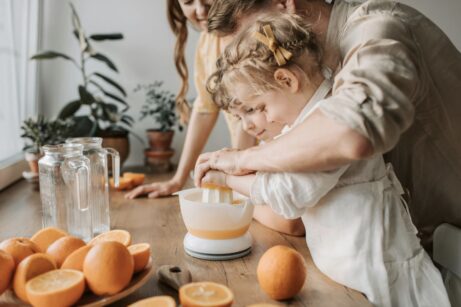Setting up the Home Environment, part III

After introducing the Prepared Environment and discussing newborn, infant and toddler home environments, this week we will take a look at how to prepare the home of a preschooler and Elementary school student.
Although the Primary and Elementary years are quite different mentally, they share a lot of similarities in terms of the physical space the child inhabits and the way they interact with it. At three years old, children cross that somewhat imaginary line from being “little” to “big kids”. They shift from the toddler “unconscious explorer” into the preschool “conscious worker” and begin to develop a reasoning mind, aided by fluency in their native language. Physically, they grow a great deal, gaining strength, dexterity and exactness of motion that allows them to interact with the “adult world” in heretofore impossible ways. Parents often find that this is the age when the child truly becomes helpful around the house: while their toddler worked on chores or cleaning for their own enjoyment and development (and often created more messes and work for the parents in the process!), the preschooler now manages these tasks effectively and efficiently.
The home environment should, naturally, change once again to accommodate this growth, as well as the mental shift that accompanies it.
Changes to the Space
The toddler’s environment used a lot of tools to aid the child in using the adult-sized world, from the potty chair to the tall dining chair – it is time for them to gradually disappear, leaving perhaps a booster seat and a few stepstools. On the other hand you can now return all of those things that had to be hidden from the toddler’s destructive tendencies: fragile items, decorations and other items that the preschooler can be expected to respect and handle with care.
The child should gain increasing access to their possessions, including their wardrobe or dresser (instead of the limited cupboard with two or three choices from a year or two ago). While it’s still a good idea to display and make accessible a limited amount of toys that are rotated regularly, there should now be more choices, and the child should be an active participant in the process – periodically helping you store things away, choosing which ones to take out, and so on; likewise with seasonal clothing. Closed bins, boxes and baskets storing larger amounts of items on the shelves are no longer the taboo they used to be – the Primary child can now orient themselves in them, particularly if they are marked or labelled.
At some point during the Primary years, the child will develop a new need: the need for privacy. The same child that used to think nothing of streaking through the house naked will now want to bathe, change clothing, or sometimes even just hide somewhere without anyone seeing them. Needless to say, this need should be accepted and respected matter-of-factly, giving the child privacy in the bathroom (at the very least) and also ideally creating a quiet spot just for them – a nook or corner where they can retreat to be by themselves. Having such a space can be a wonderful help in calming down ruffled feelings, developing emotional regulation or escaping overstimulation. You can help your child set it up for their satisfaction with books, quiet games, or even just beautiful objects to enjoy looking at and touching.
If you didn’t get one until this point, now is certainly the time to graduate to three important pieces of furniture: a “real” bed and a “real” work desk with a chair. We can highly recommend models that are designed to “grow” with the child, gradually extending to match the size of their body well into the Elementary years. Still, this space doesn’t replace a floor area for play on the floor – what was originally the “movement” area and now can be the space to build train tracks or construct Legos. In the Montessori classroom, children are free to choose whether to work at a table or on the floor, and should have at least the same freedoms and options at home.
Growing Socially
In preschool, suddenly the child’s interest in other children shifts and grows: rather than playing next to one another (“parallel play”), they now prioritize interactive, cooperative play. They develop preferential relationships and friendships and want to spent time with their friends, even – especially! – invite them over to their home. In Elementary, this becomes even more pronounced as the child’s identity within their peer group becomes painfully important to them. Sleepovers become a common and especially exciting activity, expressing the child’s readiness to take another step towards independence: spending a night away from the home.
The child’s home should then, ideally, be prepared to invite a group of children in to play and work together. In preschool, this will likely be the family room or somewhere the children will be easily supervised or kept company; in Elementary, you will likely find that the children’s need for privacy extends to their playtime and they might prefer to stay behind closed doors. Whilst it’s perfectly appropriate to require, for example, putting in an appearance to greet the adults politely, or sitting down for a group meal together, you should understand and respect that these grown children need stretches of unsupervised play, and the expression of your trust in providing it.
Playtime
As the child starts attending a preschool and later Elementary school, they enter a whole new educational and social environment with a host of new experiences to live. Many children also begin extracurricular activities at this age, such as sports, musical instruction, and others. Whilst these are all valuable opportunities, they cannot come at the expense of the child being able to rejuvenate and process their experiences whilst at home through the most natural medium: free play.
Unstructured time in which the child does whatever they please (and therefore, whatever they need – of course, within the confines of appropriate behaviour) is crucial to healthy development, including the formation of will, self-regulation and executive functioning. Some of the best materials and toys that assist the child with this are open-ended, heuristic toys: Legos, constructive blocks and mechanical playsets, creative supplies. Of course, some of the best opportunities for creative open-ended play are also to be found in the great outdoors: sticks and stones, leaves and dirt. As the child begins to develop an abstract mind and imagination, these become the best supplies for encouraging creativity, supporting “pretend play” or roleplaying, and externalizing one’s conflicts, thoughts and memories.
All these toys and equipment, even the natural ones, of course lend themselves to the social and cooperative play that becomes important, as mentioned above. Meanwhile, there is also another type of play, one that requires rule learning, and practices turn taking, positive competition and cooperation: board games and similar, which also become important and valuable at this age.
In the Household
External order of the child’s space continues to be very important to them throughout the end of the first plane of development, at six years old. The parent’s role mostly lies in helping them set up the environment so that they can maintain it easily: with shelves, areas, material set-ups and cleaning tools. The average three or four-year-old (who was brought up in a Montessori way) finds genuine pleasure in dusting their shelves, mopping the floors and putting everything away just so. However, at the start of Elementary school parents are often in for an unpleasant surprise: the formerly neat and fastidious child seems to lose any and all interest in tidiness and cleaning up.
The child’s good habits better be firmly established by now, because cleaning loses its charm and becomes what it is to most of us adults: a necessary evil. However, unlike the young toddler who could only work in obedience of their own natural impulses, or the Primary child who was enormously satisfied by this type of work, the Elementary child can (and should!) be expected to take responsibility of their own space and of the household as a whole. Not because they are naturally drawn to the work but because they understand its necessity, and because they understand that they have duties to themselves and to their family. They are now truly entering the age of chores.
As we discussed in the article dedicated to Practical Life activities, the Elementary child can take part in any number of activities related to running the household: cooking, cleaning, laundry. Gardening, if possible, is a wonderful lesson not only in the work itself but also in biology, botany and the care of a living thing.

Explore the fundamentals of Montessori parenting with this free video by Sylvia Arotin, offering insights and strategies to empower and educate your child.
School and Becoming a Student
Formal education becomes yet another rite of passage in a child’s life: transitioning from a child in the “House of Children” to a student in school. To allow the child the maximum independence, ownership and confidence in this step, it is important to give them new opportunities and tools to set them up for success.
This includes having your child make their own way in navigating the school day (transitioning to using their own alarm clock instead of being woken by the parent, using a calendar to track days of the week and month, packing their own school bag or preparing their school snacks), as well as helping them set up a truly efficient and productive work space. That work desk and chair (which up until now was an extension of the play space) now become a center of their room. It should be, of course, well-lit, ergonomic and properly sized for the child’s body to promote healthy posture and combat fatigue; however, it also needs to be well equipped and practical. We recommend a wall calendar and a time piece clearly visible from the desk, a place to store the school bag nearby, separate cupboard or shelf for books and other needs, and well organized “office” and art supplies either in clearly defined spaces on the desk or immediately near it.
A note on screens: we continue to recommend against digital “screens” in the Primary years, and for limiting them in the Elementary years. We strongly recommend against a television in the child’s room at all: particularly exposing the child to it at sleep time or when doing schoolwork; a computer may be introduced in later Elementary but should still be limited, and again, never be used before bed. Although many in our culture have become accustomed to having a television as “background noise”, it can have a devastating effect on a child’s concentration, fracturing attention and radically reducing mental output. Of course in Elementary watching a short film or show is quite a common thing: if you’d like to share a television program with your child, we recommend making it a “primary activity”: sitting down to watch intentionally, without other distractions and in a social setting, and afterwards taking time to discuss and process what you saw.
Montessori Beginnings
YOUR ULTIMATE
MONTESSORI PARENTING COURSE
FOR ZERO TO THREE
Gain clarity and confidence in your parenting to raise a resilient, independent and joyful child.


